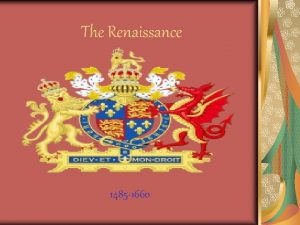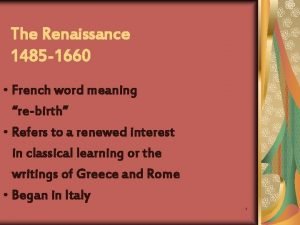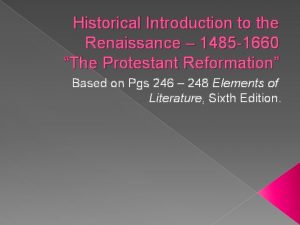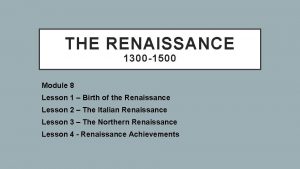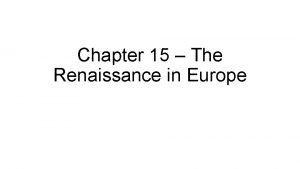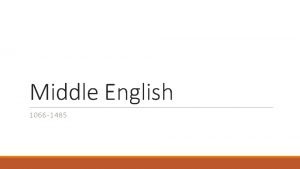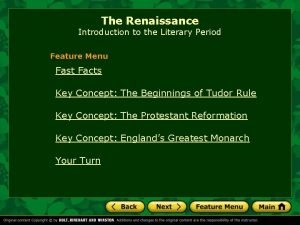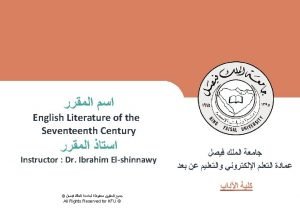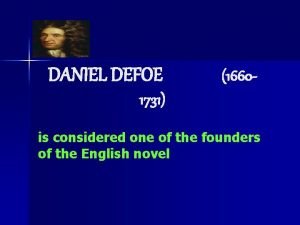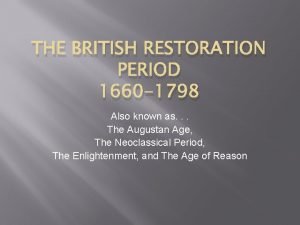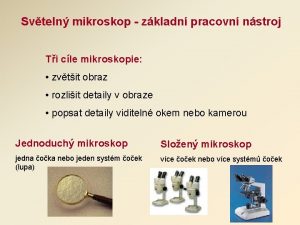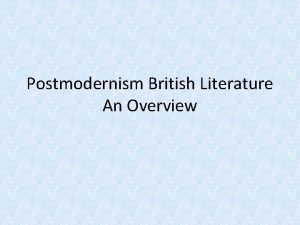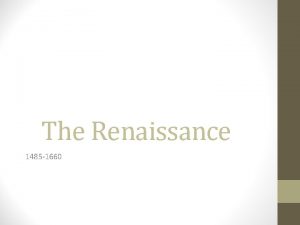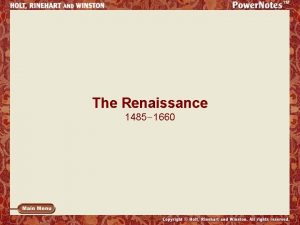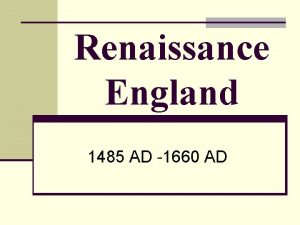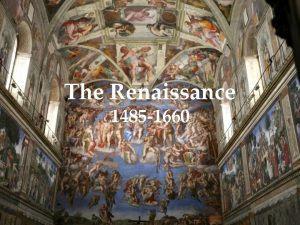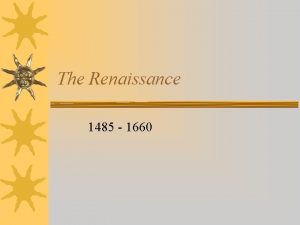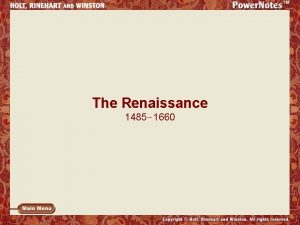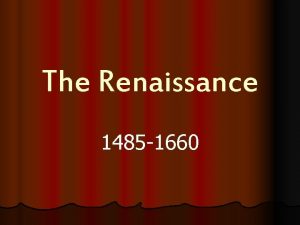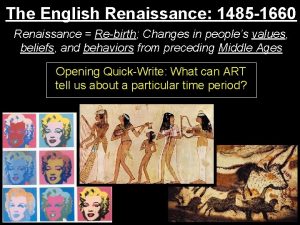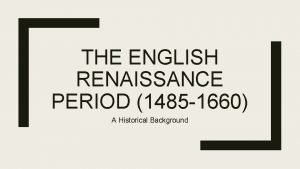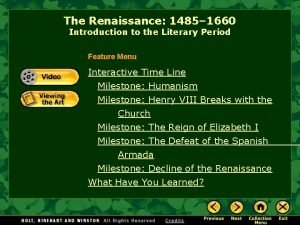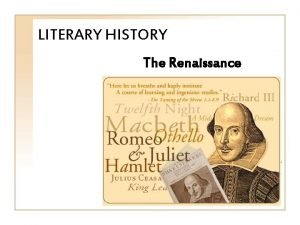Historical Introduction to the Renaissance 1485 1660 The
















- Slides: 16

Historical Introduction to the Renaissance – 1485 -1660 “The Protestant Reformation” Based on Pgs 246 – 248 Elements of Literature, Sixth Edition.

From “one” to many. � Today, there are many different types of Protestant churches: › Baptist, Methodist, Lutheran, Calvinist, Anglican, etc. Up until the 16 th century, however, there was primarily one Christian church – the Holy Roman Catholic Church. � However, disagreements with the way the church did things at that time led some to split with the church “in protest, ” thus forming the first Protestant denominations. �

It all began… In 1517 AD. A man named Martin Luther (a Catholic monk and theology professor from Germany) started the Reformation by posting a document titled the “ 95 Theses” to the door of the Castle Church in Wittenberg, Germany. � These theses were concerns about certain church practices, including the sale of indulgences. � �

Indulgences Herein, some wealthier individuals gave sums of money in exchange for a guarantee that their “sentence” in purgatory after death would be reduced. � Purgatory is one of the three realms of the afterlife in Catholicism. �

Purgatory People were / are believed to go to Purgatory, rather than Heaven or Hell, if they died without having committed serious sins, but also having not atoned for those sins. � Once in Purgatory, people continue to atone for their sins until clean, then ascend to Heaven. �

Faith Alone Another issue Martin Luther had with the Catholic church was his belief that the human condition is inherently sinful, and that no amount of good works would ever be enough to cleanse one of all sins. � Instead, Martin Luther posed the idea of “faith alone. ” � In this idea, souls did not have to confess / perform good works so as to purge their sins to get into Heaven, as believed by Catholics � Instead, they could do so by grace given freely to those who are faithful. �

Scripture Alone Another of Martin Luther’s beliefs was the idea of “Scripture Alone. ” � In this idea, Christians would rely primarily on the Holy Scriptures, not on both Holy Scriptures and church teachings, for spiritual guidance. �

Diet of Worms A “dieta” (general assembly or meeting in Latin) was held in the German city of Worms (thus, the meeting was titled “Diet of Worms”). � He was asked to recant his former assertions. � He refused, and was thus excommunicated (or expelled) from the Catholic church. �

A Painting of the Diet of Worms

Despite this… � The ideas of Martin Luther and his theses spread across Europe, beginning the Protestant Reformation. � Tomorrow, we’ll examine the role of one other prominent historical figure in this schism (split) with the Catholic church in Renaissance Europe – King Henry VIII.

Activity 1 - And believe it or not…there’s a game… Okay Mr. Valentine (me), make your speech about not endorsing any particular religious or political views whatsoever as the teacher, here. � Then, minimize this and open the game titled “Protestant Reformation the Game” whose. exe file should be in the misc media folder, games subfolder (takes a while to load). � Enjoy the ridiculous game, because what else are you going to do for a “fun” activity based on the Protestant Reformation? �

Music in the Renaissance – The Lute In Europe, lute refers to a plucked stringed musical instrument popular in the 16 th and 17 th centuries. � The lute that was prominent in European popular art and music of the Renaissance and Baroque periods originated as the Arab ʿūd. � This instrument was taken to Europe in the 13 th century by way of Spain and by returning crusaders and is still played in Arab countries. �

Origins of the Lute Like the ʿūd, the European lute has a deep, pear-shaped body, a neck with a bent-back pegbox, and strings hitched to a tension, or guitar-type, bridge glued to the instrument’s belly. � European lutes have a large, circular sound hole cut into the belly and ornamented with a perforated rose carved from the belly’s wood. �

“Greensleeves” on the Lute

By Adam Miller “Lute Hero” The Lute in Moden Works � The Lute has even made it’s way into modern video games, such as the Neverwinter Night’s third-party mod: Lute Hero (yes, a rip off of guitar hero).

Activity 2 – A Continuation of the Pastoral Activity � � � � Now that you’ve learned a bit about pastorals, it’s time to write one of your own! Remember, pastorals are about idealized countrysides, shepherds, fair ladies (nymphs), and country life. Send your spokesperson up again for another randomized card. This card will give you the “point of view” from which you will write your pastoral. Each point of view is a little different, and some are…just plain odd. When you have your point of view cards, return to your groups, share, and use our remaining time to create your own pastoral poem. This poem should be between 20 and 30 lines. We will share our poems at the end of the period.
 The renaissance 1485 to 1660 unit introduction
The renaissance 1485 to 1660 unit introduction Renaissance is a french word that means
Renaissance is a french word that means The english renaissance 1485 to 1660
The english renaissance 1485 to 1660 Renaissance (1537 ad - 1660 ad)
Renaissance (1537 ad - 1660 ad) Renaissance (1537 ad - 1660 ad)
Renaissance (1537 ad - 1660 ad) Lesson 1 the renaissance 1485
Lesson 1 the renaissance 1485 Lesson quiz 15-1 the renaissance in europe
Lesson quiz 15-1 the renaissance in europe The middle ages 1066 to 1485 unit introduction
The middle ages 1066 to 1485 unit introduction The renaissance introduction to the renaissance answer key
The renaissance introduction to the renaissance answer key Comment on paradise lost as a puritan age document
Comment on paradise lost as a puritan age document Daniel defoe (1660-1731)
Daniel defoe (1660-1731) Daniel defoe was born in 1660 into a family of dissenters
Daniel defoe was born in 1660 into a family of dissenters The restoration period
The restoration period Mikroskop 1660
Mikroskop 1660 Mikroskop 1660
Mikroskop 1660 The medieval period (455 ce-1485 ce)
The medieval period (455 ce-1485 ce) 1603-1485
1603-1485
